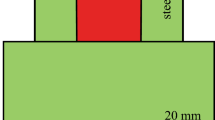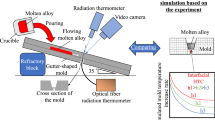Abstract
The effect of helium on heat transfer at the metal-mold interface was studied using a unique casting apparatus. Temperature, as well as displacement, measurements were carried out. The heat-transfer coefficient (HTC) at the metal-mold interface was deduced using an inverse heat-transfer procedure. Comparisons of heat-transfer characteristics were made between aluminum-based alloys solidified with and without helium at the metal-mold interface. These comparisons indicated that the onset of the metal-mold gap developed faster under helium conditions than without helium. The time decrease for the onset of the metal-mold gap with and without helium conditions can be as large as 34 pct. In addition, the average heat-transfer coefficient, from the beginning of the casting until the onset of the metal-mold gap, was higher by as much as 48 pct in the castings using helium compared to castings without the use of helium. The impact of helium on heat transfer relative to air was found to be largest with higher mold roughness. Equations were developed from the onset of the metal-mold gap, which relate the HTC against the size of the gap. These equations had the form \( h\, = \,\frac{1} {{a*G\, + \,b}}\, + \,c \). It was also found that at the onset of metal-mold gap, the rate of the heat-transfer coefficient decrease is higher at the early stages of gap development than at the later stages of gap formation.
















Similar content being viewed by others
Abbreviations
- T :
-
temperature
- t :
-
time
- C p :
-
specific-heat capacity
- k :
-
thermal conductivity
- x :
-
distance
- ρ :
-
density
- α :
-
thermal diffusivity, \( \alpha \,\, = \,\,\frac{k} {{\rho \,C_{p} }} \)
- I:
-
initial uniform temperature of mold
- \( {q}''_{{in}} \) :
-
heat flux entering the mold from the casting which is an unknown quantity to be estimated
- x 1 :
-
mold thermocouple, TC1, distance from mold-metal interface of 2 mm
- x 2 :
-
mold thermocouple, TC2, distance from mold-metal interface of 45 mm
- x 3 :
-
mold thermocouple, TC3, distance from mold-metal interface of 2 mm
- k me :
-
thermal conductivity of the casting metal
- TC1:
-
temperature measured by the mold thermocouple, TC1
- TC2:
-
temperature measured by the mold thermocouple, TC2
- TC3:
-
temperature measured by the mold thermocouple, TC3
- Δt :
-
means time-step
- Δx :
-
distance between two consecutive nodal points
- \( T^{p}_{0} \) :
-
represents the temperature of node 0 located at the mold side of the metal-mold interface and time-step, t
- \( T^{{p + 1}}_{0} \) :
-
represents the temperature of node 0 located at the mold side of the metal-mold interface and time-step, t + Δt
- T N1 :
-
numerically found temperature at x 1
- T N2 :
-
numerically found temperature at x 2
- T SM :
-
mold-surface temperature
- T SC :
-
casting-surface temperature
- h:
-
heat-transfer coefficient
References
B. Coates and S.A. Argyropoulos: Metall. Mater. Trans. B, 2007, vol. 38B, pp. 243–55
D. Doutre: Proc. Advances in Industrial Materials, D.S. Wilkinson, W.J. Poole, and A. Alpas, eds., TMS of CIM, Montreal, PQ, Canada, 1998, pp. 289–301
X. Wan and R.D. Pehlke: Paper 04–023(02).pdf, AFS Trans., 2004, pp. 193–207
H.G. Carletti: Master’s Thesis, University of Toronto, Toronto, 2006
K. Mills: Recommended Values of Thermophysical Properties for Selected Commercial Alloys, Woodhead Publishing, Abington, Cambridge, England, 2002, pp. 89–97
W.F. Smith: Structure and Properties of Engineering Alloys, McGraw-Hill, New York, NY, 1981, p. 218.
H.T. Angus: Cast Iron: Physical and Engineering Properties, Butterworth & Co. Press, London, 1976, pp. 113–21.
S.A. Argyropoulos, A.C. Mikrovas and D.A. Doutre: Metall. Mater. Trans. B, 2001, vol. 32B, pp. 239–46
S.A. Argyropoulos, A.C. Mikrovas and D.A. Doutre: Metall. Mater. Trans. B, 2001, vol. 32B, pp. 247–52
M. Trovant and S.A. Argyropoulos: Metall. Mater. Trans. B, 2000, vol. 31B, pp. 75–86
M. Trovant and S.A. Argyropoulos: Metall. Mater. Trans. B, 2000, vol. 31B, pp. 87–96
Acknowledgments
The authors thank Novelis for providing critical in-kind contribution for this project. In particular, they also thank Dr. Don Doutre for very interesting and constructive discussions. The authors also thank the Natural Sciences and Engineering Research Council of Canada for its financial support. In addition, they would like to thank MAGMA Foundry Technologies Inc. for donating the Magmasoft simulator.
Author information
Authors and Affiliations
Corresponding author
Additional information
Manuscript submitted September 4, 2007.
Rights and permissions
About this article
Cite this article
Argyropoulos, S.A., Carletti, H. Comparisons of the Effects of Air and Helium on Heat Transfer at the Metal-Mold Interface. Metall Mater Trans B 39, 457–468 (2008). https://doi.org/10.1007/s11663-008-9143-9
Published:
Issue Date:
DOI: https://doi.org/10.1007/s11663-008-9143-9




